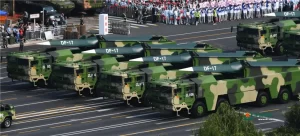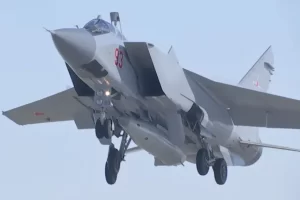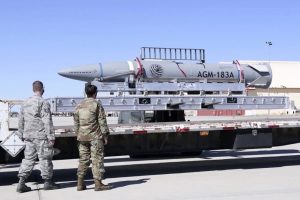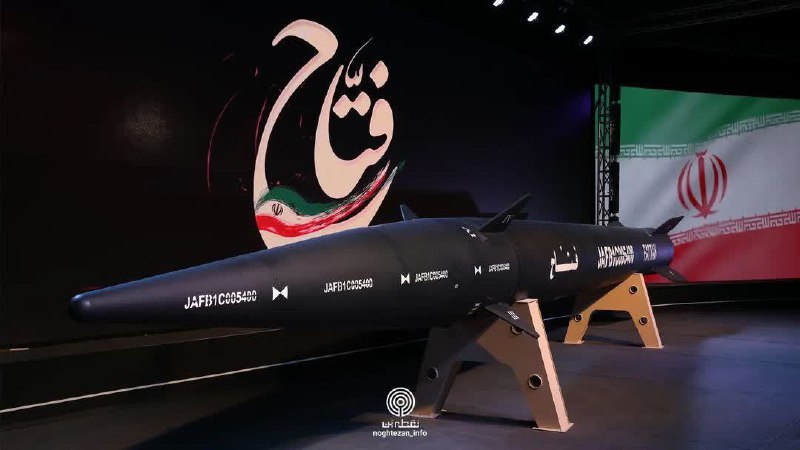On Tuesday, Iranian President Ebrahim Raisi unveiled what was claimed to be Iran’s first hypersonic weapon, named “Fattah” or “Conqueror” in Farsi.
Iranian state media claims that the missile “has a range of 1,400 kilometers and hits the target at a speed of Mach 13 to 15.”Footage of the missile being launched shows that the system consists of a first stage booster derived from what is likely a Kheybar-Shekan solid-fuel medium-range ballistic missile and a maneuverable reentry vehicle (MaRV) powered by a sustainer motor.
Just to note that much of the footage consists of CGI.
ICYMI: Iran's Islamic Revolutionary Guard Corps on Tuesday morning unveiled its first hypersonic missile named "Fattah" with a range of 1400 km (870 miles), in a ceremony attended by President Raisi and IRGC commanders.
Iran claims Fattah can hit Israel 400 seconds after launch. pic.twitter.com/TxIzzFFPsl— Iran International English (@IranIntl_En) June 6, 2023
General Amir Ali Hajizadeh, head of the IRGC’s aerospace program, also claimed that the missile cannot be intercepted by modern missile defense systems, stating that “The Fattah cannot be destroyed by any other missile due to how it moves in different directions and at different altitudes.”
There is this notion that in order to be a hypersonic weapon, it just needs to travel at or in excess of Mach 5, which is 3,800 miles per hour, but this is really not the case. The definition of hypersonic weapons nowadays has two criteria, which is that it must travel at or over Mach 5 and that it must also be maneuverable (both vertically and horizontally) within the atmosphere.
So with that being said, there are hypersonic weapons and weapons that move at hypersonic speeds. The latter have been around for many decades and a perfect example would be intercontinental ballistic missiles (ICBMs), such as the United State’s LGM-30G Minuteman III, which can travel at Mach 23 (17,500 mph). The reason why most missiles are not considered “hypersonic weapons” is because missiles follow a predetermined, arched trajectory and lack maneuverability within the atmosphere. I understand that the definition is a bit muddy, but roping in ICBMs and hypersonic cruise missiles into the same boat does not do their differences any justice.
Features of Iran's hypersonic missile, which cannot be destroyed by any missile:#Fattah pic.twitter.com/N0Z2sR6Hyq
— IRNA News Agency (@IrnaEnglish) June 6, 2023
There are primarily two different kinds of hypersonic weapons: cruise missiles (HCMs) and glide vehicles (HVGs). In short, hypersonic cruise missiles travel at a constant speed and altitude for the duration of their flight utilizing scramjets (supersonic combustion ramjets). Scramjets are “air breathing,” meaning that they constantly take in surrounding air for their combustion and do not need an oxidizer like other rocket and missile systems.
Glide vehicles work by being placed on top of rockets that are launched to a high altitude at great speed, where they then decouple and glide back to Earth. HVGs do not have any propulsion mechanisms that can generate thrust, meaning they gain hypersonic speed from the rockets themselves and can travel at speeds in excess of Mach 20 depending on the rocket they are attached to. In Iran’s case, they are using MaRVs, which as previously stated are propelled by a motor and do not glide like HVGs.
HCM and HVG’s speed and maneuverability make them practically impossible to track and intercept. To date, there are no existing methods to shoot them down.

For China, they currently service the DF-ZF hypersonic glide vehicle, which entered service in 2019. The DF-ZF works like any standard HGV and is outfitted on DF-17, DF-21, and DF-31 ballistic missiles. This HGV was designed specifically for anti-ship operations, which pose a threat to American aircraft carriers if a conflict were to break out.
For Russia, they currently service the nuclear-capable Avangard HGV, which entered service in 2019. The system is launched via ICBMs, such as the UR-100UTTKh, R-36M2 and RS-28 Sarmat, allowing the HGV to attain claimed speeds up to Mach 27. Russia’s Strategic Rocket Force currently employs at least six of these weapons.

They also service the Kh-47M2 Kinzhal, which is a nuclear-capable hypersonic aero-ballistic air-to-surface missile, which is derived from the 9K720 Iskander ballistic missile, but with added maneuverability and extended range. The Kinzhal, or “Dagger,” entered service in 2017 to be launched by MiG-31K supersonic interceptors and Tu-22M3M supersonic bombers. The Kinzhal became the first ever hypersonic weapon to be used in combat during the 2022 Russian Invasion of Ukraine.
The United States has been trying to develop hypersonic weapons for decades, but have never been able to field one largely due to lack of funding and development issues. To date, the United States does not have any serviceable hypersonic weapons that have been implemented in its armed forces outside of testing.
The United States Air Force ended its development of the hypersonic AGM-183A Air-launched Rapid Response Weapon (ARRW) back in April following years of issues plaguing the program such as failed tests and funding issues. The ARRW was supposed to be a glide-boosted weapon, meaning that the entire weapon uses rockets to reach speeds of Mach 20 before an integrated glide vehicle releases and heads towards the target. Development began in 2018 with Lockheed receiving nearly $500 million in funding and initial testing proved to be optimistic, with President Trump touting it as the “Super-Duper Missile.”

However, when it came to test flights, all three failed in 2021. Soon after, the Air Force signaled that it had no plans to buy ARRWs in its 2023 budget after already cutting funding to the program by nearly a half. The project wasn’t dead at the time, however, and a series of successful free flight test flights in 2022 raised some hopes that the project could pull through to be the United States’ first serviced hypersonic weapon. Despite this, the ARRW’s latest testing did not meet expectations and was not considered successful.
The end of the ARRW program does not mean that the United States is out of the hypersonic weapons arms race. The Hypersonic Air-breathing Weapon Concept (HAWC) program is still active, with development being taken up by Lockheed Martin and Raytheon. The system is an air-launched, scramjet powered hypersonic cruise missile Test flights since 2021 have been more fruitful than that of the ARRW, with DARPA planning on expanding the project through its “More Opportunities with HAWC program” (MOHAWC). Timelines for serviceability remain unknown at this time.


